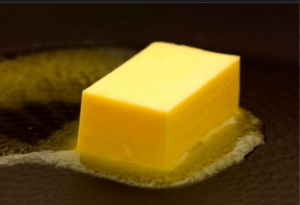Butter, and why it is different than all other dairy.
-Richard Maurer, ND
I am a sometimes paleo eater but always a butter advocate – here is why.
 Dairy gets glorified or booed off stage depending upon the audience. I understand the divide and do, in fact, speak from both sides of the canyon. In my clinical practice specializing in metabolic health and recovery, I direct most people with blood high insulin levels to avoid most dairy products…unless their goal is to have a bigger body.
Dairy gets glorified or booed off stage depending upon the audience. I understand the divide and do, in fact, speak from both sides of the canyon. In my clinical practice specializing in metabolic health and recovery, I direct most people with blood high insulin levels to avoid most dairy products…unless their goal is to have a bigger body.
[How do you know if you have high fasting insulin? Run the Metabolic Progress Panel through ULTA]
Lactose sugar raises our blood levels of insulin, an anabolic (body building) hormone to a greater extent than glucose sugar itself. And diary proteins like casein and some globulins, raise insulin more than other non-dairy proteins. But dairy fat is not part of the dairy dilemma narrative. So, butter is spared, right? I believe so, let me explain why.
Lactose content
Milk contains about 12-13 grams of lactose per 8-ounce serving. Yogurt is close – even with the bacterial conversion of some lactose to lactic acid the lactose content remains greater than 10 grams per 8-ounce serving. Butter? 1 Tablespoon of butter equals 0.01 grams
Our FDA labels in the U.S. don’t require labels to state amounts less than 0.5 grams so butter package labels simply list <0.5 g under the sugar listing.
Is cultured butter better?
The addition of beneficial bacteria to the cream before it is churned for butter does a couple things. The bacteria alter the nature of the fat by converting the tiny amount of lactose into lactic acid. This acidity creates a different texture and flavor to the resultant butter. Theoretically it has “less” lactose and is easier to digest, but the numbers here are not overwhelming. Most people with lactose intolerance can tolerate several grams of lactose before problems occur, so reduction of 0.005 gram in a TBS does not matter. I personally choose cultured butter because of the improvement in flavor and texture of butter. I also look for any chance to regularly ingest a traditionally cultured food.
Protein content
A basic butter only contains about 0.1 grams of protein per tablespoon (14 grams). The FDA lists that “light butter” is much higher in protein, at 0.5 grams per 1 tablespoon and lower in fat. Light butter is an oxymoron at best. Better quality butters should be higher in fat content not lower. I eat the better part of 100 grams of protein on most days. Therefore 0.1 grams protein in a TBS of butter is 1/1000 of my day’s protein—insignificant for sure. Taken further, some cultured butters can reach 88% butter fat, compared to 80% for the lesser commercial brands—and thus contain protein below 0.08 grams protein per TBS.
Pure dietary fat has no effect upon insulin levels in our body. Butter from cows that have eaten green things exposed to sunlight has a significant amount of vitamin A, D and K.
What about olive oil?
Endless press headlines comment on the “health benefits of olive oil” but I suspect olive oil is so good because it is  not bad. Compared to ubiquitous vegetable oils that become rancid with cooking and storage—like canola, corn, soy, sunflower and safflower oil—olive oil is stable and more healthful. Butter offers these benefits and still delivers fat soluble nutrients to fuel our health. In my daily diet, I use both butter and olive oil with emphasis on quality cultured butter.
not bad. Compared to ubiquitous vegetable oils that become rancid with cooking and storage—like canola, corn, soy, sunflower and safflower oil—olive oil is stable and more healthful. Butter offers these benefits and still delivers fat soluble nutrients to fuel our health. In my daily diet, I use both butter and olive oil with emphasis on quality cultured butter.
For those who must correct weight/metabolism/lipids by avoiding dairy products—butter is exceptional in more ways than one. Bon appetite.
-Richard Maurer



Comments are closed.